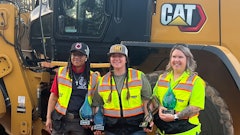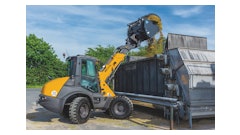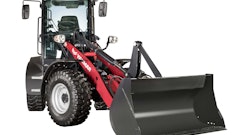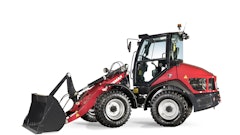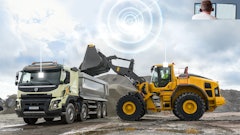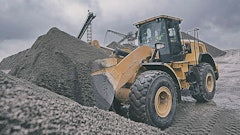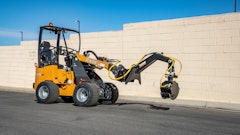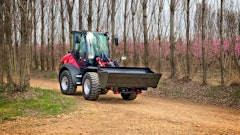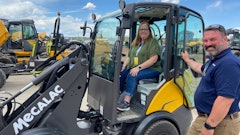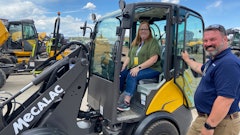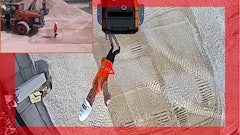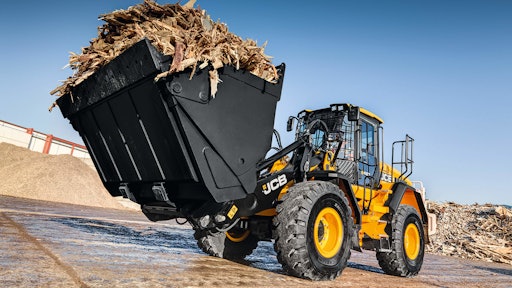
Due to their numerous technological enhancements, wheel loaders will likely become more and more prevalent on jobsites nationwide. As has been the case in recent years, the global wheel loader market continues to expand on a steady basis. There are likely several reasons for the growth and expectations are that it will continue to expand in the future. In fact, in August 2022, market research company Facts and Factors published a research report predicting the market’s size will increase annually from 2022-2028 (the last year that the company projected growth statistics). According to the analysis, the market’s growth will be considerable, as its size is anticipated to rise to $19.6 billion by 2028, while its compound annual growth rate (CAGR) will potentially be 3.1%.
Despite the dynamics associated with the market’s consistent growth, one factor, above all else, especially stands out: advanced technology. For instance, according to Javier Marin, product manager, Heavyline, JCB North America, wheel loaders’ technologies have recently been enhanced in numerous ways, from boosts in operator comfort and safety features, to improved fuel efficiency and increased machinery versatility.
“These technological advancements are positively impacting operators’ confidence, as their wheel loaders are now safer to operate and more user friendly,” Marin said. “Additionally, these innovations enable equipment owners to utilize their wheel loaders across diverse environments, ultimately leading to a better return on investment (ROI).”
Much like JCB North America, Hitachi Construction Machinery Americas Inc. is dedicated to technological advancements, as evidenced by its ZW-7 wheel loaders’ variety of operator aid technology innovations, including the following:
- Approach speed control. Due to this innovation, the wheel loaders are able to improve their V-loading applications as they regulate speed, decrease fuel consumption and minimize operators’ input. The primary reason? They can adjust their travel speeds, while utilizing fewer pedal operations during the loading process, according to Matt Koester, product manager for wheel loaders.
- Auto power up. Each ZW-7 wheel loader has an auto power up function too, which enhances its hill climbing performance, through the use of inertial measurement units. By identifying slopes and incorporating the information provided by the inertial measurement units, the function also increases each wheel loader’s engine speed whenever it encounters hills. In turn, whenever the wheel loader travels uphill, engine speeds won’t decline.
- Payload checker. In addition, ZW-7 wheel loaders offer operators a payload checker that weighs its bucket’s materials and displays such information within their interior cab monitors, in order to load out trucks and stockpiles more accurately. Consequently, unnecessary trips to stockpiles will decline, according to Koester.
“The payload checker has four modes: tip-off to truck, tip-off to pile, auto-add and manual-add, each of which allows it to manage loads, according to operators’ specific applications,” he added. “It’s also equipped with a warning function that notifies operators whenever their buckets are overloaded, which improves their safety during operation.”
- Peripheral vision camera system. Offering operators high visibility and situational awareness, the ZW-7 wheel loader’s peripheral vision camera system, known as Aerial Angle, provides a wide, 270-degree bird’s-eye view of its immediate environment.
“While utilizing three cameras, which are mounted on the wheel loader’s rear, the system enables operators to visualize its left-hand and right-hand sides on a monitor, which is located in its cab,” Koester said.
- Rear object detection system and warning function. Finally, some ZW-7 wheel loaders have a rear object detection system, too, which is integrated within the loader’s main sub monitor. Due to this system, operators don’t have to examine as many screens as they previously did.
Aside from Hitachi, DEVELON has released a variety of technological innovations for its wheel loaders, as well. For example, according to Jacob Sherman, product and dealer marketing manager, at DEVELON, the manufacturer has introduced its Transparent Bucket for each of its wheel loaders. A standard feature for its -7 Series models beginning this year, the technology enables operators to see through their wheel loaders’ buckets, while using cameras, along with an additional monitor in their cabs. As a result, jobsite visibility and, in turn, safety should increase.
Moreover, for further visibility—up to 270 degrees, in fact—the manufacturer has also created an around view monitor (AVM) camera system. An optional object detection system is available for -7 Series wheel loaders as well, leading to even more visibility, regardless of when operators use them, according to Sherman.
Alongside technological advancements, David Spooner, wheel loader product manager, HD Hyundai Construction Equipment North America, believes that the rise in wheel loader use is associated with the upturn in construction projects, too. After all, according to Spooner, between 2024 and 2027, construction projects are expected to grow by as much as 4% in the United States alone.
“This is particularly due to investments in the manufacturing sector, housing (both single and multi-family), energy and transportation,” Spooner said.
Wheel Loaders' Technology Offerings Expand
As the aggregates of construction projects and wheel loaders continue to increase, the impact of technological advancements simply can’t be overlooked. First off, the construction industry’s continuous labor shortage issues are leading wheel loader owners to simplify their operations more, according to Sherman. Not only do they have fewer workers to conduct more job tasks, but they only have so much time each day to achieve exactly what they need to. The more enhanced wheel loaders are, resulting in higher productivity, the better. And the more technology that’s available, the more enhanced wheel loaders will be.
“Even experienced workers can benefit from the increased usage of technology in wheel loaders,” Sherman said. “For example, wheel loaders’ optional onboard weighing systems provide more accurate and faster loading.”
He added, “Additionally, some ‘smart scales’ use weighing intelligence and solid-state sensors to communicate information, such as real-time productivity and performance reports for extraction, processing and load-out operations.”
Depending on what wheel loaders are equipped with, they can achieve other goals, too. As an example, with high-lift or standard arms, they can be used for a majority of bucket applications. However, according to Koester, if they have a parallel link arm configuration instead, they will excel in fork and tool carrier applications, as their attachments will remain parallel with the ground whenever their arms move up or down.
“As a result, operators will have increased control as they load and unload items,” Koester said.
To continuously enhance wheel loaders’ loading and unloading capabilities, along with a variety of other capacities, Hyundai is focused on releasing further technological innovations that will positively impact wheel loaders’ functionalities down the road. For starters, it has manufactured an offering known as the HiMate system, which enables wheel loader owners to immediately determine whether or not their wheel loaders are being utilized in the most efficient manner possible.
“For instance, they can see statistics like fuel consumption, idle time, machine location and engine run time, in relation to actual working time, among other factors,” Spooner said. “Additionally, they can visualize active faults and receive instant notifications about anything that needs immediate attention. And they can see any upcoming or overdue maintenance, in order to help alleviate downtime.”
Meanwhile, the company has recently released a two-pass loader too, known as the HL985A. Featuring a 9.13-yard bucket and a 12.5-foot wheelbase, resulting in increased stability, the HL985A also has a Tier 4 Cummins X12 engine that produces 420 horsepower and 1,700 foot-pounds of torque. Moreover, it has heavy-duty ZF axles, each of which has axle cooling, illustrating yet again that wheel loaders’ technologies are steadily advancing.
“It comes standard with an onboard weighing system and a rear-view mounted camera with All Around View Monitoring (AAVM) as well, resulting in 360-degree viewing,” Spooner said.
To help operators load and move more materials, DEVELON’s -7 Series wheel loaders also feature heavy-duty axles, ensuring their lift capacity is consistently high. As an example of their axles’ durability, every -7 Series wheel loader, aside from the manufacturer’s DL200-7, has robust ZF axles. On the other hand, the DL200-7 wheel loader has Dana axles instead, which are also very durable.
“In addition, auxiliary hydraulic piping is routed to the base of each -7 Series wheel loader’s lift arm,” Sherman stated. “By positioning hydraulic piping at the base of its lift arm, it will be shielded from any potential damage caused by debris or rocks, leading to a possibly longer lifespan.”
Enhanced Operator Comfort
There is no doubt about it: When it comes to modern wheel loaders’ designs, operator comfort is a significant priority. To steadily enhance operator comfort, JCB North America has substantially improved its cab visibility, by enlarging windows and integrating exterior cameras. The result is a larger field of vision, allowing for higher productivity and improved safety.
“JCB North America is also focused on increasing its wheel loaders’ cab space, offering heated and cooled operator seats and providing more ergonomic designs to further enhance operators’ comfort, especially during long hours of operation,” Marin said.
Likewise, Hyundai is now offering four-way adjustable arm rests on its wheel loaders, leading to more operator adjustability and, in turn, comfort. To increase operators’ comfort even more, the manufacturer’s wheel loaders’ air ride seats have wider cushions. And, according to Spooner, quick couplers make for a smoother ride.
“Due to the wheel loaders’ quick couplers, operators can easily change their attachments and improve their ride control,” Spooner said. “Therefore, they’ll have smoother rides, especially as they traverse rough terrain with loads.”
Regarding Hitachi’s ZW-7 wheel loaders, operators’ comfort was also a key design priority, according to Koester. As an example, each ZW-7 wheel loader has enhanced sealing, thereby increasing cab pressurization. Consequently, the cabs are not only more comfortable, but cleaner and quieter too, thus improving operators’ driving experiences significantly. Each ZW-7 wheel loader comes standard with a fully adjustable, heated air ride seat, which integrates a seat-mounted armrest with electric-hydraulic controls, along with switches that have ergonomic locations.
“The armrest and controls can be adjusted 3.5 inches forward or reverse, in order to comfortably accommodate operators of all sizes,” Koester said. “To reduce operators’ fatigue, along with each cab’s aggregate of hydraulic lines, the ZW-7 wheel loaders have electric-hydraulic joystick controls, as well. And, finally, as a result of the wheel loaders’ 8-inch, anti-glare LCD monitors, which have Bluetooth radio, operators will have hands-free phone capacity, too.”
To improve operator comfort within the cab, DEVELON has released an easy-to-read, user-friendly and multilingual touchscreen, known as the DEVELON Smart Touch display. Additionally, each of its -7 Series wheel loaders feature a rearview camera that increases operators’ visibility behind them. For even further visibility, particularly to its sides, the wheel loaders also have a considerable amount of glass in their cabs. By enhancing their visibility in several ways, the -7 Series will increase operators’ comfort at the same time, as they’ll feel more secure while using them.
“Every -7 Series wheel loader has a robust heating and air conditioning system, too, which helps operators remain cool during the summer and warm throughout the winter,” Sherman said. “Furthermore, since the -7 Series wheel loaders have LED lights that brighten their work areas, operators will be able to confidently work in low-light situations, as well as during the night.”
Manufacturers Focus on Increasing Jobsite Safety
Aside from enhancing their comfort, many wheel loader manufacturers are also determined to increase operators’ jobsite safety. As an example of its resolve to improve operators’ safety, Hitachi has altered its ZW-7 wheel loaders’ cab pillars’ design and positioning. In addition, it has changed the layouts of each of its cab’s monitors and switch panels, resulting in wider fields of view.
“By designing cabs with panoramic visibility, Hitachi is creating a safer working environment for its operators,” Koester said.
Alongside its Transparent Bucket, AVM camera system and optional object detection system, DEVELON has created a backup alarm for its -7 Series wheel loaders. As a result, operators will have yet another safety offering, as they utilize their wheel loaders on various jobsites, including those that have numerous natural and man-made hazards.
Following suit with DEVELON, with regard to providing even further safety offerings, Hyundai has added a second monitor to its HL985A’s AAVM. Consequently, operators will acquire information concerning their wheel loaders on their cabs’ main monitors, while also viewing their jobsites on entirely different monitors than their main ones.
“The manufacturer provides cab guards, as well, which not only protect the cabs, but the operators, too, as they conduct job tasks like forestry,” Spooner said. “To ensure that wheel loaders are maneuvered to safe locations, in the event of engine losses or hydraulic function losses, they also have emergency steering. And, finally, they have rear detection systems, as well, which will help prevent collisions whenever operators reverse them—technology that will likely enhance operators’ jobsite safety considerably.”
Primary Benefits of Wheel Loaders
While looking back on the recent, ever-increasing popularity of wheel loaders, which many anticipate will only continue to increase for years to come, manufacturers believe there are a variety of reasons why they’ve become so popular, as they offer several distinct advantages, when compared to other equipment on the market.
First, according to Marin, wheel loaders are especially known for their ease of use, versatility, high payload capacity and wide size range, which enable them to cater to various applications.
“They excel at efficiently moving large amounts of material from one location to another, while outperforming other equipment in their size category,” he stated. “Just as importantly, they can also adapt to different work environments, leading them to be a preferred choice among most operators.”
Koester agreed, saying that wheel loaders can move large amounts of materials—and numerous types, ranging from dirt, to gravel, to rock, to sand—in a highly efficient manner. This maneuverability is especially noticeable in truck loading operations, according to Spooner.
“Aside from their maneuverability, wheel loaders have larger bucket capacities, too,” he said. “Additionally, they’re more cost efficient, as operators won’t need to utilize as much equipment to transport a large amount of materials, as they otherwise would have.”
Upon reflecting on wheel loaders’ past, present and future, Sherman emphasized they’ve been key components to operators’ construction jobsites for decades, rather than just recent years. After all, according to Sherman, their middle components can articulate, enabling them to turn tightly on busy jobsites, all while minimizing the potential for workers’ injuries. In addition, since wheel loaders, have quick couplers, operators can change their attachments in a relatively effortless fashion. Therefore, their downtime will diminish, while their productivity will improve long term, as they will be able to focus on other tasks, aside from timely attachment adjustments.
“Simply put, when operators need to lift, move and dump material, there’s nothing better than a wheel loader,” Sherman said. “I believe that will remain the case well into the future.”











